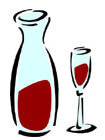For the average American wine consumer European wine labels can pose a challenge.
 It’s an intimidating experience to stand in front of racks filled with bottles that seem to be marked with an indecipherable code. Given the vastness of the wine selection that a consumer contends with these days it doesn’t make things easier. Many faced with this dilemma give up and buy something they recognize or choose an appealing label. Australian winemakers, for example, are geniuses at creating fuzzy penguins and happy kangaroos that have proven wildly successful at luring buyers. This is unfortunate because many of the good wines are hidden beneath labels that can seem incomprehensible and forbidding.
It’s an intimidating experience to stand in front of racks filled with bottles that seem to be marked with an indecipherable code. Given the vastness of the wine selection that a consumer contends with these days it doesn’t make things easier. Many faced with this dilemma give up and buy something they recognize or choose an appealing label. Australian winemakers, for example, are geniuses at creating fuzzy penguins and happy kangaroos that have proven wildly successful at luring buyers. This is unfortunate because many of the good wines are hidden beneath labels that can seem incomprehensible and forbidding.
The first barrier is the language and unfortunately not much can be done about that. Someone looking to become knowledgeable about wine should acquaint themselves with some of the basic words used to describe wine. There are many sites on the internet as well as books that define these common words. As the same words are used again and again, mastering them should not be an overly difficult task.
The most important concept to understand when perusing European wines is that they are named for the place where they came from. Geography is considered the single most important factor when classifying a wine. This is different from American wine as well as other New World wine producing countries where the wine is named for the grape, or varietal that the wine is made from. The European system reflects centuries of trial and error so that by now growers have figured out the best places to grow a particular grape.
This system is now a law and it is called various names in different countries. In France for example it is known as A.O.C or Appellation d’Origine Controlle. This law insures that a wine grown within a certain region meets set standards that guarantee to the consumer that the wine will reflect its place of origin. On a French wine label the town or region where the wine is grown is set in the largest type. A bottle labeled Beaujolais therefore can only be from the Beaujolais region and has met certain standards.
Another aspect of these laws is that the alcohol level must be clearly displayed, this because every region or appellation has to adhere to a minimum and maximum range of alcohol to be considered true to its origins. France and Germany probably have the most stringent and elaborate set of laws regarding the production of wine. In France every inch of grape growing land has been rigidly classified. While this is confusing and sometimes frustrating it also reflects a dedication to making the best possible product. Keep in mind the best places for growing grapes were discovered ages ago so when you drink a wine from these areas you are drinking the fruits of centuries of labor and thought. These classifications evolved over time by what the market demanded. Historically wines were sold at auction to merchants and certain areas became recognized as consistently commanding higher prices. A nice example of the free market working effectively.
As time goes on inevitably New World wines will become identified by the area from where they’re grown. This is already happening today. For instance a Cabernet based wine from the Napa Valley in California can command a higher price than other California regions. Certain vineyards and specific geographic regions are becoming recognized all over California. The same holds true for South America and Australia. Yet this process of figuring out where the best land is takes a long time. Fifty years ago California produced vast quantities of wine labeled simply by what grape it was made from. Today the astute consumer examines the label to see precisely where the grape was grown, as characteristics of the geography are becoming established. Even with modern technology this process takes many years of experimentation. Like anything truly good, a great wine cannot be rushed.